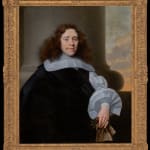 Fig. 1
Isaack Luttichuys (1616 – 1673)
Fig. 1
Isaack Luttichuys (1616 – 1673)Constantia Boudaen Courten (b. 1631)
Oil on canvas: 41 ¾ x 32 7/8 in. (106 x 83.5 cm.)
Signed and dated, upper left: ‘I Luttichuys / Anno 1657’
Private collection.
Isaack Luttichuys (1616 – 1673)
Further images
Provenance
By direct descent within the Huydecoper family, Wulperhorst, Zeist, The Netherlands; until
Hendrik Maximiliaan Huydecoper (1857 – 1950), Wulperhorst; to his niece
Louise Ernestine de Beaufort-de Beaufort (1879 – 1960), De Heiligenberg House, Leusden; thence by descent, until 2022.
Exhibitions
B. Ebert, Simon and Isaack Luttichuys, Munich 2009, p. 567, no. A68.
Literature
Utrecht, Centraal Musueum, Lustrumtentonstelling uit het kunstbezit van Reünisten van het Utrecht Student Corps, 22nd June – 11th July 1956.
A painter principally of portraits, and occasionally of still lifes, Isaack Luttichuys was baptised at the Dutch church of Austin Friars in London in 1616, the son of the merchant Barent Luttichuys (b.c.1573) and Magdalena Symonsdr. Dykwel (b.c. 1580 - 1645). His father, a merchant, originally hailed from Münster and his mother from Goes, but they married in Amsterdam in 1601, before relocating to London circa 1604. Isaack had at least eight siblings, who were all born in London, but most did not survive childhood. One of his older brothers was Simon Luttichuys (1610 – 1661), who began his painting career specialising in portraits in England but would later become a leading still life painter of the “Golden Age” in the Netherlands.
Isaack probably moved to Amsterdam in the 1630s, certainly by 1638, when his first known dated work was completed.[1] In April 1643 he married Elisabeth Adolfs Winck in Amsterdam; seemingly they had one surviving daughter together, Cornelia (b. 1644), but Elisabeth died soon after, presumably whilst giving birth to their son, and was buried in the Westerkerk on 19 August 1645. The following spring, Isaack posted banns (i.e. a church notice announcing an intended engagement) with Sara Grebert, who would give birth to five children, all of whom were baptised (and/or buried) in the Westerkerk.[2]
The artist lived and worked at 25 Lauriergracht in Amsterdam between at least 1643 and 1646, before moving to the Singel, where he remained for the rest of his life.[3] 25 Lauriergracht was the site of Govert Flinck’s ‘Schildershuis’, a lively artistic hub, with rentable living space and studios for fellow artists - as well as a brothel in its basement. It would have proved a useful opportunity for Luttichuys to meet other artists and be introduced to potential patrons who frequented the building.[4] Despite this close association with Flinck, Luttichuys seems to have aligned more with the lighter, and crisper stylings of Bartholomeus van der Helst (1613 – 1670), than with Rembrandt’s school of dramatic chiaroscuro. Whilst less theatrical and radical, their sense of palpable realism and place make Luttichuys’s graceful portraits some of the most aesthetically pleasing of the period. Towards the end of his life, the artist seems to have had suffered from a period of financial imprudence, as he had to pledge many of his paintings and other belongings to honour a debt. He died in March 1673 and was buried in Amsterdam’s Westerkerk.
Joan van der Merckt, the subject of this commanding portrait, was from a prominent Amsterdam-Middelburg family, which had strong connections to Antwerp. His grandfather, Pieter van der Merckt, who was the son of a successful trader with links in Spain and the Levant, had moved to Middelburg after the fall of Antwerp in 1585. His son from his first marriage, also called Pieter (1587 - 1625), married Sara de Fray, whose parents also came from Antwerp, in Amsterdam in 1615. They had five children together, our subject Joan being one of them; he made a successful career within the Zeeland hierarchy, partly due to his marriage, in 1649, to the wealthy Constantia Boudaen Courten (1633 – c.1701) [Fig. 1]. He carried many responsible positions locally and nationally: he was nominated as a councillor and alderman of Middelburg, acted as a director of the VOC at the Zeeland Chamber, and was closely involved with the Admiralty Council in Amsterdam for the province of Zeeland. Joan and Constantia had three children together: Johan, who moved to Amsterdam and founded a second Amsterdam branch of the Van der Merckt family; Pieter, who a councillor and president of the Council of Flanders; and Sara (d.1713).[5] Upon Joan’s premature death in 1663, aged only forty, Constantia remarried to the widowed Jan Baptista Hochepied (1634 – 1686).[6]
[1] Anne Blaeu, mother of Pieter C. Hooft, 1638.
[2] Their first child was baptised on 21 April 1647; a son Isaack on April 19, 1648; Magdalena on 9 May 1649; Catharina on 27 October 1650; another son called Isaack was buried on the same day. Sara died in the autumn of 1657 and was buried in the Westerkerk on 15 October 1657 (Ebert 2009, p. 56).
[3] Ebert, 2009, pp. 18 – 19 & 48 – 49.
[4] After Flinck died in 1660, the house was sold to his (and Rembrandt’s) art dealer, Kunsthandel Uylenburgh, who operated there until its bankruptcy in 1675. See: https://www.lunenberg.info/het-schildershuis-aan-de-lauriergracht [accessed 23 October 2023].
[5] A. Teunis, Encyclopaedia of Zeeland, 1982 - 1984 [accessed online, 23 October 2023: https://encyclopedievanzeeland.nl/Van_der_Merckt/EvZ1982-1984].
[6] His portrait, and that of his first wife Geertruyd Spiegel (1635 – 1662), were also painted by Isaack Luttichuys in 1656.




